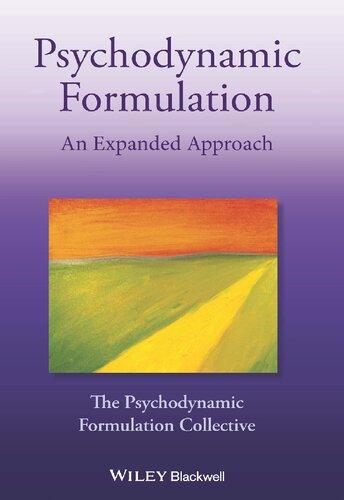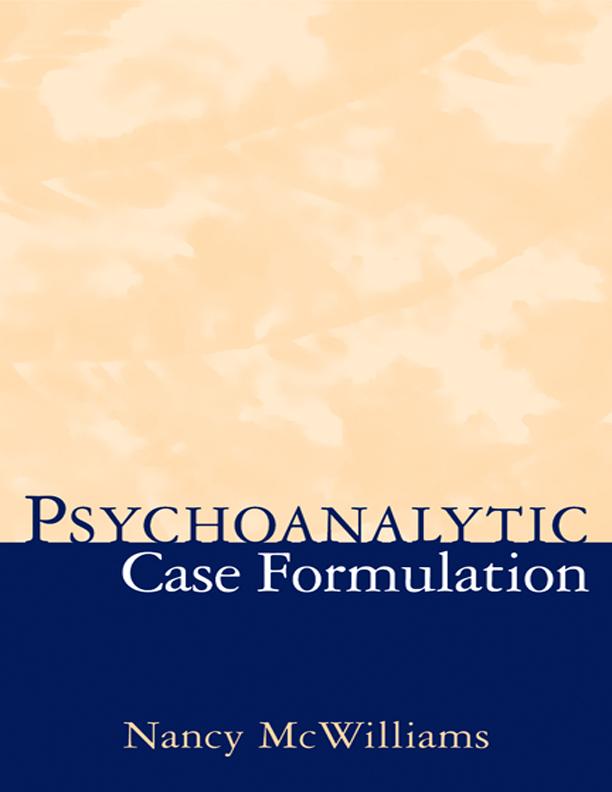Psychoanalytic Case Formulation 1st Edition, (Ebook PDF) Visit to download the full and correct content document: https://ebookmass.com/product/psychoanalytic-case-formulation-1st-edition-ebook-pd f/
More products digital (pdf, epub, mobi) instant download maybe you interests ...
Guide to Psychoanalytic Developmental Theories – Ebook
PDF Version
https://ebookmass.com/product/guide-to-psychoanalyticdevelopmental-theories-ebook-pdf-version/
Chemical Product Formulation Design and Optimization: Methods, Techniques, and Case Studies Ali Elkamel
https://ebookmass.com/product/chemical-product-formulationdesign-and-optimization-methods-techniques-and-case-studies-alielkamel/
Psychoanalytic Psychotherapy: A Practitioneru2019s
Guide
https://ebookmass.com/product/psychoanalytic-psychotherapy-apractitioners-guide/
PSYCHODYNAMIC FORMULATION : an expanded approach. The psychodynamic formulation collective John Wiley
https://ebookmass.com/product/psychodynamic-formulation-anexpanded-approach-the-psychodynamic-formulation-collective-johnwiley/
Magnesia Cements: From Formulation to Application 1st Edition Mark Shand
https://ebookmass.com/product/magnesia-cements-from-formulationto-application-1st-edition-mark-shand/
Case Files Emergency Medicine, Fourth Edition (LANGE Case Files) – Ebook PDF Version
https://ebookmass.com/product/case-files-emergency-medicinefourth-edition-lange-case-files-ebook-pdf-version/
Clinical Case Studies for the Nutrition Care Process 1st Edition, (Ebook PDF)
https://ebookmass.com/product/clinical-case-studies-for-thenutrition-care-process-1st-edition-ebook-pdf/
Neuroscience for Neurosurgeons (Feb 29, 2024)_(110883146X)_(Cambridge University Press) 1st Edition Farhana Akter
https://ebookmass.com/product/neuroscience-for-neurosurgeonsfeb-29-2024_110883146x_cambridge-university-press-1st-editionfarhana-akter/
Case Studies in Psychotherapy 7th Edition, (Ebook PDF)
https://ebookmass.com/product/case-studies-in-psychotherapy-7thedition-ebook-pdf/
PSYCHOANALYTIC CASE FORMULATION Psychoanalytic CaseFormulation NancyMcWilliams,PhD
© 1999NancyMcWilliams
PublishedbyTheGuilfordPress ADivisionofGuilfordPublications,Inc. 72SpringStreet,NewYork,NY10012 http://www.guilford.com
Allrightsreserved
Nopartofthisbookmaybereproduced,translated,storedina retrievalsystem,ortransmitted,inanyformorbyanymeans, electronic,mechanical,photocopying,microfilming,recording,or otherwise,withoutwrittenpermissionfromthePublisher.
PrintedintheUnitedStatesofAmerica
Thisbookisprintedonacid-freepaper.
Lastdigitisprintnumber: 987654321
LibraryofCongressCataloging-in-PublicationData
McWilliams,Nancy.
Psychoanalyticcaseformulation/NancyMcWilliams. p.cm. Includesbibliographicalreferencesandindex. ISBN1-57230-462-6
1.Psychiatry—Caseformulation.2.Personalityassessment. 3.Behavioralassessment.4.Interviewinginpsychiatry. 5.Psychotherapistandpatient.I.Title. RC473.C37M381999 616.89—dc2198-56044 CIP
Formyhusband, WilsonCareyMcWilliams About the Author NancyMcWilliams,PhD, teachespsychoanalytictheoryandtherapyat theGraduateSchoolofAppliedandProfessionalPsychologyatRutgers—TheStateUniversityofNewJersey.Asenioranalystwiththe InstituteforPsychoanalysisandPsychotherapyofNewJerseyandthe NationalPsychologicalAssociationforPsychoanalysis,shehasaprivatepracticeinpsychodynamictherapyandsupervisioninFlemington, NewJersey.Herpreviousbook, PsychoanalyticDiagnosis:UnderstandingPersonalityStructureintheClinicalProcess (GuilfordPress, 1994),hasbecomeastandardtextinmanytrainingprogramsforpsychotherapists,bothintheUnitedStatesandabroad.Shehasalso authoredarticlesandbookchaptersonpersonality,psychotherapy, psychodiagnosis,sexuality,feminism,andcontemporarypsychopathologies.
Preface THEfirsttimeasupervisoraskedmetoventurea“dynamicformulation”ofthecasematerialIhadjustheard,Ibecameinstantlyincompetent.IknewvaguelywhatIwasbeingaskedtodo—namely,tosuggest howtheperson’ssymptoms,mentalstatus,personalitytype,personal history,andcurrentcircumstancesallfittogetherandmadesense—but Idrewablankastowheretobegin.Thiswasmyintroductiontothe moreinterpretive,synthetic,artisticaspectsofpsychodiagnosis.UntilI hadbeenaskedforthatformulation,Ihadrarelyinmytrainingbeen encouragedtoworkinferentially,toopenmyselfuptoacreativeprocessfueledbyintuition,tofeelmywayintoanotherhumanbeing’sintimatelifeandformulatethatperson’ssufferinginawaythatwould expresshisorheruniquecategoriesofsubjectiveexperienceratherthan thepreformatted,“objective”categoriesofreceiveddiagnosticwisdom. Likeanywell-socializedstudent,Ihadgottengoodatmemorizingfactualdata,tellingteacherswhatIthoughttheywantedtohear,andlookingfortherequisitenumberof“signs”thatwouldeitherconfirmor ruleoutawell-knowndiagnosticentity,butthisassignmentaskedfor somethingdifferentandwasinitiallyveryintimidating.
Mostofuslearnpsychodynamiccaseformulation,asIeventually did,byidentificationwithmentorswhoaregoodatitandwhocan demonstratehowbetterunderstandingproducesbettertreatment.Iam notentirelysurethatthiscreative,affectivelyinfusedprocesscanbe capturedinabook.ButIwasalsouncertaininitiallywhetherpsychoanalyticcharacterdiagnosiscouldbeeffectivelytaughtviatheprinted page,andIhaverepeatedlyheardfromstudentsandpractitionersthat mywritingonthattopichasbeenhelpful.Sowhenmyeditorpointed outthatin PsychoanalyticDiagnosis (McWilliams,1994),despitemy
harpingontheimportanceofsensitivelyassessingpersonalitystructure, Idevotedonlyafootnotetohowonearrivesatsuchanassessment,I beganthinkingabouthowtoconveyinwritingthewaysinwhichexperiencedpsychodynamictherapiststhinkaboutpatients.
Theycertainlydonotthinkofthemsimplyintermsofthecriteria for“disorders”thatarecodifiedinthe DiagnosticandStatisticalManualofMentalDisorders (DSM)oftheAmericanPsychiatricAssociation.Totheircredit,theauthorsoftheDSM-IVhavebeenexplicit aboutthelimitationsof“disorder”taxonomies,especiallyfromthe pointofviewofthepracticingclinicianratherthanthatoftheempirical researcher(AmericanPsychiatricAssociation,1994,p.xxv).Tobea goodtherapist,onemusthaveanemotionalappreciationofindividual personsascomplexwholes—notjusttheirweaknessesbuttheirstrengths, notjusttheirpathologybuttheirhealth,notjusttheirmisperceptions buttheirsurprising,unaccountablesanityundertheworstofconditions.
Mypreviousbookconcernedtheimplicationsofpersonalitystructurefortreatment.Anappreciationofaclient’scharactertypeis,however,onlyoneofthefactorsthatinfluencestherapistsintheirdecisions abouthowtoworkwithsomeone.Wewanttoknowwhatstressesaccountforanyperson’scomingtousatthisparticulartime,howheor shehasunconsciouslyunderstoodthosestresses,andwhataspectsof hisorheruniquebackgroundhavecreatedavulnerabilitytothiskind ofstress.Wealsowanttoknowhowtheperson’sage,gender,sexual orientation,race,ethnicity,nationality,educationalbackground,medicalhistory,priortherapyexperience,socioeconomicposition,occupation,livingarrangements,responsibilities,andreligiousbeliefsareconnectedwiththesituationaboutwhichwearebeingconsulted.Weask abouteatingpatterns,sleepingpatterns,sexuallife,substanceuse,recreations,interests,andpersonalconvictions.Weputallthattogether intoanarrativethatmakesthishumanbeingandhisorherpsychopathologycomprehensibletous,andwederiveourrecommendations andourwayofrelatingtotheclientfromthatnarrative(seeSpence, 1982).Thus,incontrasttomypreviousbookondiagnosis,thisone concernsitselfnotjustwiththoseaspectsofpeople’spsychologiesthat compriseAxisIIoftheDSMbutwithdataappropriatetoAxesI,III, IV,V,andotherareas.
Thisbookismoreabouttheprocessthantheoutcomeofdiagnosis. Eventhoughtherearenumerousgoodsourcesonhowtoconductan initialinterview(e.g.,MacKinnon&Michels,1971;Othmer&Othmer,1989),andseveralrecentpublicationsexplicatingdifferentperson-
viii Preface
alitydiagnosesordisorders(Akhtar,1992;Millon,1981;Kernberg, 1984;Josephs,1992;Benjamin,1993;Johnson,1994),Iamnotaware ofmanyprimersonhowtherapistsreflectonthedelugeofinformation theyobtaininadiagnosticinterview—howtheyputitintonotonlya diagnosticformulationbutalsoageneralpsychodynamicone.OnenotableexceptionisaguidebyPaulPruyser,whoin1979notonlydescribedtheprocessofpsychodynamicallyinfluencedinterviewingbut alsochampioneditsimportancewitheloquence.Twentyyearslater, muchhaschanged,bothinpsychoanalysisandinthecultureatlarge. Currently,givenpressuresforquick,atheoreticaldiagnosis,itmaybe evenmoreimportantthanpreviouslyforthoseofusinthemental healthbusinesstoremindourselvesofthecomplexitiesandsubtleties involvedintryingtounderstandpeopleandtheirpsychologicalproblems.
IamhopingtoreachthesameaudienceIhaveaddressedpreviously,namely,peoplecommittedtobecomingtherapists,whethertheir fieldispsychiatry,psychology,socialwork,counseling,education,pastoralwork,nursing,psychoanalysis,relationshipcounseling,ortheexpressivetherapiesthatinvolvethevisualarts,music,anddance.Beyond thenarrowgoalofteachingpractitionershowtodevelopandrefinea dynamicformulation,Ihopealsotoillustratethevalueofthekindsof knowledgethatconstitutemainstreampsychoanalyticexpertise,andto providesupporttomycolleaguesandstudents,somanyofwhomare sufferingfromthecurrent,market-drivenclimateofcynicismaboutintensiveandsustainedmentalhealthcare.Thepublicdeservestherapists whomaintaintheintegrityofpsychologicalservicesandwhoresistlettingeconomicpressurescompromiseeithertheircommitmenttoadeep understandingofindividualsorthecompassionthatnaturallyderives fromthatcommitment.
Preface ix
Acknowledgments THOSE whoinfluencedmyunderstandingofcaseformulationindirect,personalwaysduringmytrainingincludeGeorgeAtwood,BertramCohen,JudithFeltonLogue,MonicaMcGoldrick,StanleyMoldawsky, DanielOgilvie,IradjSiassi,thelateSilvanTomkins,Duncan Walton,andmyteachersattheNationalPsychologicalAssociationfor Psychoanalysis,especiallytheremarkableArthurRobbins.PsychoanalyticcolleaguesonwhoseexpertiseIcontinuetodrawincludeHilary Hays,ReidMeloy,BarbaraMenzel,GeneNebel,ArthurRaisman,Kit Riley,JonathanSlavin,SueSteinmetz,DianeSuffridge,andBryant Welch.Inaddition,manyseminalthinkersintheanalyticcommunity havebeengeneroustome:ThelateHelenBlockLewissupportedmy earliesteffortstogetmywritinginprint;BertramKaron,Otto Kernberg,StephenMitchell,FredPine,DorisSilverman,andthelate LloydSilvermanallencouragedmyworklongbeforemyprofessional reputationwasestablished.
Forcontinuingprofessionalencouragementandpromotionofmy scholarship,IthankStanleyMesser,chairoftheClinicalPsychologyProgramattheGraduateSchoolofAppliedandProfessionalPsychology (GSAPP)atRutgers.SandraHarris,RuthSchulman,andmycolleaguesat Rutgershavemadeitapleasuretoworkthere.JamieWalkupgaveadraft ofthefirstchaptersofthisbookhistypicallythoroughandthoughtfulcritique,muchtoitsbenefit.MystudentsatGSAPPhavecontributedeven moretomyongoingeducationthanmyfellowfacultymembers.Iamalso gratefultoMichaelAndronicoandthemembersofmydiversityself-study group—ClayAlderfer,BrennaBry,CaryCherniss,LewGantwerk,Bob Lewis,HiltonMiller,andJesseWhitehead—forcontinuingtoexpandmy consciousness into new areas of individual difference.
Acknowledgments xi
Myunderstandingofindividualityanditsclinicalimplicationsis similarlynourishedattheInstituteforPsychoanalysisandPsychotherapyofNewJersey(IPPNJ).ThehospitabilityofIPPNJtoopenintellectualinquiryreflectstheecumenicaltonesetbymyfriendAlbertShire, itsDirectorsince1984.Amongmycolleaguesthere,KarinAhbel,JosephBraun,JeanCiardiello,CarolGoodheart,TomJohnson,Linda Meyers,MarshaMorris,LinPillard,JeffreyPusar,HelenRaytek,Peter Richman,JeffreyRutstein,HeleneSchwartzbach,ShawnSobkowski, NinaWilliams,andSandraYarockhavebeenparticularlyimportantto myprofessionalgrowth.StanleyLependorfdeservesspecialthanksfor readingthefinishedmanuscriptunderthepressureofadeadlineand makingusefulsuggestionsforitsimprovement.Mysuperviseesat IPPNJandelsewhere,individuallyandinmyprivateseminars,have consistentlyhelpedmetorefinemythinkingaboutcaseformulation.
LongbeforeIwasananalyst,Iabsorbedwaysofconceptualizing individualityfromMargaretFardyandDorothyPeavey,whoeducated meabout,andpromotedmyrespectfor,personalitytypesIhavenever seendiscussedinofficialnosologies.Amongmynontherapistfriends,I amgratefultoCherylWatkinsandRichardandBrettTormeyforboth cheeringmeonandkeepingmehumble,toVelvetMillerforhersteadfastfriendshipovermorethanthirty-fiveyears,toNancySchwartzfor thewarmthofherconcernandtheconsolationsofherwit,andtoFred Millerforhisenergyandhisgenius.Assomeonewhofindsmeaningin playaswellaswork,andwhoneedstheformertodothelatter,IamindebtedtoDeborahMaher,GeorgeSinkler,andtheCopperPenny Players.
Mymostcherishedmentorandsupporterismyhusband,Carey,to whomthisbookisdedicated.Asascholarofuncommonerudition,he appreciatesthedemandsofthecreativeprocessandnevercomplains whenIampossessedbyit.Afeministlongbeforeitwaspoliticallycorrect,hehasalwaysdoneatleasthalfourhomemakingandparenting, activitiesbeforewhichallotheraccomplishmentspale.Mydaughters, SusanandHelen,havecorrespondinglyexpressedprideratherthanresentmentatmydedicationtomywork,makingiteasyformeto achievewithoutguilt.IalsoappreciateTheodoreGreenbaum,Edith Sheppard,andespeciallythelateLouisBerkowitzforwhatIhave learnedintheirrespectiveoffices.
IhavebeenfortunatetoworkwithGuilfordPublications.Sue Elkind,theprepublicationreviewerforGuilford,improvedthisvolume considerably.KittyMoore,myeditor,hasnowdeftlyguidedme throughallthestagesoftwobooks.Shebearsfullresponsibilityforthe
Acknowledgments
existenceofthisone,havingstartedtonagmeaboutwritingagain when PsychoanalyticDiagnosis wasstillinpress.WhenIprotestedthat IhadalreadysaideverythingIhadtosay,shetoldmethathadnever stoppedanyoneelsefromwritingasecondbook.
Finally,Ithankmypatients.Itissoconventionalforpsychotherapiststosaythisthatitishardtodosoinawaythatsoundssincere,but IdoubtthatIamunusualamongclinicalauthorsinfeelingastaggering debttothosewhocometomeforprofessionalhelp.Therearetruths onecanlearnfromapersonwhohasbeentryingtobarehisorhersoul inincreasingdegreesofemotionalnakednessoverseveralyearsthatno otherkindofinquirycanaccess,andfortheserevelationsIamgrateful. Individualpatientshavekindlygiventheirpermissionfortheanecdotes abouttheminwhatfollows.Theyhavealsoconfirmedthatthosevignettesareaccuratedepictionsoftheiremotionalexperienceseven thoughIhaveomittedorchangedsomedatafortheirprotection.Being atherapistisafascinating,moving,andgratifyingwaytospendone’s life,andIdeeplyappreciatethosewhohaveallowedmetodothatjob withthemandwhohaveintheprocesstaughtmemostofwhatIknow.
xii
Introduction 1
OntheSubjective/EmpathicTradition2 OnBeingaTherapistandTeachingPsychotherapy attheTurnoftheCentury4 Organization7
ChapterOne:TheRelationshipbetweenCaseFormulation andPsychotherapy 9 BasicPremises11 GoalsofTraditionalPsychoanalyticTherapy12 CaseFormulationforTherapeuticRatherThan ResearchPurposes25 Summary28
ChapterTwo:OrientationtoInterviewing 29 MyOwnStyleofInitialInterviewing30 ConcludingComments45 Summary47
ChapterThree:AssessingWhatCannotBeChanged 48 Temperament49 Genetic,Congenital,andMedicalConditionswithDirect PsychologicalEffects52 IrreversibleConsequencesofHeadTrauma,Illness, andToxicity53 UnchangeablePhysicalRealities56 UnchangeableLifeCircumstances58 PersonalHistory61 Summary63
xiv Contents
ChapterFour:AssessingDevelopmentalIssues
65 SomeCautionaryandOrientingCommentsonPsychoanalytic DevelopmentalTheory66 ClassicalandPost-FreudianDevelopmentalModelsandTheir ClinicalApplications73 Summary83
ChapterFive:AssessingDefense 85 ClinicalversusResearchConsiderationsinAssessment ofDefense87 CharacterologicalversusSituationalDefensiveReactions90 ClinicalImplicationsofAssessingDefense92 Summary101
ChapterSix:AssessingAffects
102 AffectsintheTransference/CountertransferenceField105 AffectStatesasPresentingProblems108 EvaluatingtheDiagnosticMeaningofAffect110 TherapeuticImplicationsofGettingItRight aboutAffect116 Summary121
ChapterSeven:AssessingIdentifications
122 IdentificationsSuggestedbyTransferenceReactions123 Identification,Incorporation,Introjection, andIntersubjectiveInfluencing124 ClinicalImplicationsofUnderstandingIdentifications129 ClinicalPossibilitiesWhereCounteridentification Predominates132 Ethnic,Religious,Racial,Cultural,and SubculturalIdentifications135 Summary138
ChapterEight:AssessingRelationalPatterns 139 RelationalThemesintheTransference143 RelationalThemesoutsidetheTherapySituation152 ImplicationsofRelationalPatternsforLong-Term versusShort-TermTherapies155 Summary156
ChapterNine:AssessingSelf-Esteem
158 TheSignificanceofUnderstandingSelf-EsteemIssues158 PsychoanalyticAttentiontoSelf-Esteem161 ClinicalImplicationsofAssessingSelf-Esteem166 Summary179
ChapterTen:AssessingPathogenicBeliefs
TheNatureandFunctionofPathogenicBeliefs181 DevelopingHypothesesaboutPathogenicBeliefs186 ClinicalImplicationsofUnderstanding PathogenicBeliefs190 Summary199
ConcludingComments
SomeFinalAdvice208
Introduction THEideasthatcomprisemythinkingherewereoriginallyorganized inresponsetoaninvitationfromJamesBarrontocontributeanessayto ananthologyentitled MakingDiagnosisMeaningful:EnhancingEvaluationandTreatmentofPsychologicalDisorders (1998).Infact,this bookisamuch-expandedelaborationofthatchapter,withadifferent audienceinmindandamorecomplexcollectionofaimsthatItrytoarticulateinwhatfollows.Inhisletterabouttheproposedbook,Barron raisedquestionsabouttyingthediagnosticprocessmoremeaningfully totheactualityofclinicalwork,aboutthecomplexrelationshipsbetweendiagnosisandprognosis,abouttheextenttowhichdiagnosis informstreatment,aboutrelatingdiagnosistodevelopmentalprocesses, andaboutthetensionbetweendiagnosesthatseekdescriptivespecificityyetobscurethecomplexityofpatientsanddiagnosesthatcapture complexitybutsacrificespecificity.
Ihaveponderedsuchquestionsforyears.Assucceedingeditionsof the DiagnosticandStatisticalManualofMentalDisorders (DSM)of theAmericanPsychiatricAssociation(1968,1980,1987,1994)have becomeincreasinglyobjective,descriptive,andputativelyatheoretical, theyhaveinevitablyminimizedthesubjectiveandinferentialaspectsof diagnosisonwhichmostcliniciansactuallydepend.Operatingmoreor lessinvisiblyalongsidetheempiricallyderivedcategoriesoftheDSMis anothercompendiumofwisdom,passeddownorallyandinpracticeorientedjournals:clinicalknowledge,complexlydeterminedinferences, andconsistentimpressionsmadeontheharnessedsubjectivitiesoftherapists.Inanyindividualcase,thesedatacoexistsomewhatuneasily withwhateverformaldiagnosticlabelthepatienthasbeengiven.One aimIhavehereistorepresentthatinvisible,sharedsetofprocedures andreflections.
2 PSYCHOANALYTICCASEFORMULATION
ON THE SUBJECTIVE/EMPATHIC TRADITION Fromtheperspectiveofanempiricalscientist,humansubjectivityis generallyconsideredadetrimenttoaccurateobservation.Fromthatof theclinician,subjectivityallowsaccesstoknowledgeabouthumanbeingsthatonecouldneverhaveofothersubjectmatter(onepresumes thatphysicistsrarely“empathize”withparticles).Manycontemporary psychoanalyticwriters(e.g.,Kohut,1977;Mitchell,1993;Orange, Atwood,&Stolorow,1997)essentiallydefinepsychoanalysisasthescienceofsubjectivity,inwhichtheanalyst’sempathyistheprimarytool ofinvestigation.MuchofwhatIcoverinthisbookreflectsthissubjective/empathicorientation.Thereisanimportantplaceforclinicalobservationsmadefromthisperspective,especiallywhentheyare scrupulouslyamassedandrepeatedlycomparedwiththoseofcolleagues.
Severalyearsago,Iagreedtobearesearchsubjectforadoctoral dissertationinvestigatingdifferencesindiagnosticpreferencesbetween psychoanalyticandcognitive-behavioraltherapists.Iconsentedto“diagnoseinmyusualway”certainmaterialthatwouldbepresentedto meonvideotape.Thetapepurportedlyshowedapatientdescribingcertainproblems.Iwastoviewitandthenfilloutaquestionnaire.Myimmediateandpersistingreactiontothevideowasthatthewomandescribinghersymptomswasnotapatient;inherrelationshiptothe camera,therewasacompleteabsenceoftheusualemotionalatmosphereonefeelsinthepresenceofasufferingpersonaskingforhelp.I wasquicklyawarethatIcouldthereforenot“diagnose”herinthe usualwayImakeclinicalassessments—namely,byempathicimmersion inthesubjectiveexperienceofthepersonseekingatherapist’sexpertise andthedisciplinedexplorationofwhatsheprovokedinmyownsubjectivity.Thefirstitemonthequestionnairewas“Whatwasyourfirst reactiontothepatient?”Iresponded,“Thatshewasanactress,nota realpatient.”Thesubsequentquestions,whichassumedthatthevideotapedwomanwasinfactapatient,wereimpossibletoanswer.
Icalledinthestudentandexplainedtohermyproblem.Ihadbeen askedtodiagnoseinmy“usualway,”butmyusualwayrequiredmeto feelthepresenceofapersonwhowasreallyaskingforhelp.IsaidIwas nottryingtobedifficult,butIcouldnotfitmyusualstyleofdiagnosis intothedemandsoftheexperiment.Theresearcherconfirmedthatthe videotapedwomanwasanactressbutaskedmetoimagineanywaythat shewasarealpatient.IsaidIcouldnotdothis:Diagnosisformeisnot astrictlyintellectualexercise,responsiveonlytodescribedsymptomatology.Inexasperation,theexperimenterdecidedtoexcludemefrom
Introduction 3
herstudy,sinceIwasnotabletocooperatewithherresearchonitsown terms.Thefindingsshelaterpublishedsimplyomittedtheassessment practicesoftherapistslikeme,whobringamoreholistic,subjective, interactionalsensibilitytothetaskofunderstandinganotherhumanbeing.
Analogousomissionshappenallthetimewithpsychoanalyticdata. Informationisignoredbecauseitisnot“neat,”objectivelydescribable, fullofdiscrete,observablebehavioralunits(cf.Messer,1994).Therefore,itisnosurprisethatwehavealotofempiricaldataoncognitivebehavioraltherapiesandfarlessonpsychoanalyticones.Onlya cognitivelyimpairedindividualcouldhonestlyconcludefromthissituationthatcognitive-behavioraltreatmentsworkandthatpsychoanalytic therapiesdonot.Wearemissingdata,butwearenotinpossessionof datademonstratingthatpsychoanalytictreatmentslackeffectiveness. AsGeorgeStricker(1996)hasremarked,weshouldnotconfusetheabsenceofevidencewiththeevidenceofabsence.What can beconcluded isthatweneedtoinvestintheveryexpensive,complex,andcreativeresearchthatpsychoanalysisrequirestoestablishitsempiricalstatus. Meanwhile,thoseofuswhoarealreadyconvincedoftheefficacyof psychoanalyticworkoweatleastsomeaccountofourthinking.
Infairnesstothecriticsoftraditionaltherapy,thereisampleevidencethatpsychoanalyticassumptionshaveoftenbeenmistaken(one thinks,forexample,ofsomeofFreud’smorepeculiarideasaboutfemalesexuality),reflectingsmug,culture-boundconvictionsthatnow lookquaintatbest,harmfulatworst.Becauseofthelimitationsoflore, therewillprobablyalwaysbeahealthytensionbetweenthesubjectively infusedoraltraditionandtheobjectivelyorientedsyndromalone.Anothersourceoftensionisthatpracticeoftenlurchesaheadofresearch, forthesimplereasonthattherapists,hearingfromacolleaguethata newtechniquecanhelppatients,willtryitbeforewaitingforfullempiricalvalidation(therecentpopularityofeyemovementdesensitizationandreprocessing[Shapiro,1989]orthought-fieldtherapy[Callahan&Callahan,1996;Gallo,1998]cometomindhere).
Itisverydifficulttodogoodresearchonconventional,long-term therapy,andfewofuswhofeelthecallingtobetherapistsalsohavethe temperamentofthedispassionatescientist(seeSchneider,1998,onthe romantictraditioninpsychology).Wearenot,however,indifferentto science.AtleastsincethetimeofSpitz(1945),analyticpractitioners havebeendeeplyinfluencedintheirpracticeandintheirdevelopment oftheorybycontrolledresearch,especiallyresearchindevelopmental psychology.Anotheraimofthisbookistoshowhowexperiencedana-
4 PSYCHOANALYTICCASEFORMULATION
lyticpractitionersapplyrelevantresearchfindingstothedemandsof formulatingacase.
ON BEING A THERAPIST AND TEACHING PSYCHOTHERAPY AT THE TURN OF THE CENTURY Itisanironyofourtimesthatatthepointwhenpsychotherapyhasalmostcompletelylostitsstigma,atleastinthemiddleclasses,andatthe pointwhenarespectableliteratureonitseffectivenesshasaccumulated (Luborsky,Singer,&Luborsky,1975;Smith,Glass,&Miller,1980; Lambert,Shapiro,&Bergin,1986;VandenBos,1986,1996;Lipsey& Wilson,1993;Lambert&Bergin,1994;Messer&Warren,1995;Roth &Fonagy,1995;Seligman,1995,1996;Howard,Moras,Brill,Martinovich,&Lutz,1996;Strupp,1996),weareexperiencingpoliticaland economicpressuresthataredemoralizingpractitioners,discouraging clientsfromseekinghelp,punishingclinicianswhoareabletoinspire patients’willingnesstostayintreatmentlongenoughtoaccomplish somethingenduring,andredefiningas“therapy”anonconfidentialrelationshipthatmaybesummarilystoppedatanypoint(cf.Barron& Sands,1996).
Becomingagoodtherapistisinherentlyarduousandtime-consuming, butlately,thetaskhasbeencomplicatedbyanxietiesamongaspiring cliniciansthattheywillnotbeabletopracticethedifficultarttheyhave madesomanysacrificestomaster.Asateacheroftherapists,Ihave seenevidencethattheseanxietieshavebeenrisingsteadilyinrecent years.Forexample,inmyintroductorysurveyofpsychoanalytictheory atRutgers,Itypicallyassignapaperaskingstudentstoanalyzeoneof theirdreamsinclassicalFreudianfashion.Occasionallyakindof“class theme”emergesinthepapers,ofteninvolvingseparation(studentsusuallytakethiscourseintheirfirstgraduatesemester)orself-esteem(not easytomaintainingraduateschool).Inarecentsemester,almosthalf theanalyzeddreamscontainedimagesofanintrusive,arbitrary,unempathicauthority—hostilepoliceofficers,angryschoolprincipals,autocraticnuns,andthelike.WhenIreportedthispatternandaskedclass membershowtheyunderstooditsmeaning,theyassociatedimmediatelytotheirapprehensionsaboutpracticeina“managedcareworld” wheresomebureaucraticdirectivewouldsuddenlyoverridetheirclinicaljudgment.
IfIhadbeenwritingthisbookfifteenyearsago,itwouldnothave thepolemicaledgeithasnow.Weareinaperiodofpainfulcrisisabout
Introduction 5
healthcareingeneralandpsychotherapyinparticular.Therehasessentiallybeenacorporatetakeoverofthehealthcaredeliverysystem,and likemosthealthcareprofessionals,Iamhighlyskepticalabouttheapplicabilityofcorporateandcommercialmodelstothehelpingprofessions.AlthoughIfindithardtoimaginethattherewilleverbeatime whenpeoplewillnotwanttotalktohighlytrainedothersabouttheir problems,ifperfunctory,insincere,andfrustratinginterventionsare representedaspsychotherapy,itwillnotbemanyyearsbeforesignificantnumbersofpeoplewillthinktheyhave“triedtherapy”andfound itwanting.Theyareunlikelytothinkabouttryingitagain.
Theserealitiesmakeitevenmorecompellingfortherapiststodo theirjobconscientiouslyandeffectively.Ifaclientisrestrictedtoa short-termtherapyrelationship,itismoreimportant,notless,tooperatefromasounddiagnosticbasis.Ifthejobthepatientwantsdonecannotbedoneundertheconditionsthatapayingthirdpartyinsistson,it isuptothetherapisttobehonestaboutthatandtoknowhowtoconveytotheclientanunderstandingofthatperson’sparticularpsychologyanditstherapeuticrequirements—toimpartadynamicformulation inordinarylanguage(cf.Welch,1998).Communicationsofthisnature canthemselvesbeunderstoodormisunderstoodbasedonhowastute thetherapistisaboutthepatient’soverallpsychology.
Itisacommoncontemporarybelief,especiallyamongmanaged carepersonnel,insurancecompanyexecutives,andsomeacademicpsychologists,thatpsychotherapy,especiallypsychodynamictherapy,is wastefulandineffective.Theresearchthathasbeencitedinself-serving waysbymanythird-partypayerstojustifythemostminimalinterventionsinthenameoftreatmenthasconsistedmostlyofstudiesinwhich time-limited,identicalinterventionsaredeliveredtocarefullyselected, randomlyassignedpatientswithsimplediagnoses,whoseprogressis evaluatedstrictlyaccordingtothefateofthespecificsymptomfor whichtheycametotreatment(seeParloff,1982;Persons,1991).As Seligman(1996)haspointedout,suchproceduresdiffermarkedlyfrom psychotherapyasitisactuallypracticed.Conventionaltherapyistypicallyopen-ended,withthepatientinfluencingtimeoftermination;itis self-correcting,inthattherapistsreadilychangetheirapproachwhen somethingisnotworking;itoftenreflectstheclient’sactiveanddiscriminatingselectionofatherapistwithwhomheorshefeelscomfortable;itusuallyconcernsmultipleandinteractingproblemsratherthan isolatedsymptoms;andthetherapist’sandpatient’scriteriaforoutcomeincludenotjustsymptomreliefbutimprovementingeneralfunctioning.
6 PSYCHOANALYTICCASEFORMULATION Complicatingmatters,theriftbetweenacademicpsychologistsand dynamicallyorientedpractitioners,forwhichbothgroupsbearsome responsibility,hasaffectedtheundergraduateandgraduateteachingof psychology.Notwithstandingafewfriendlyuniversitydepartments,the settingshospitabletopsychoanalyticscholarshiphavebeenfreestandinginstitutesandhospitalsoutsidetheacademicmainstream.Because mostacademicpsychologistshavehadscantexposuretoanalyticallyinformedpractice,theory,andscholarlyresearch,theircommentstostudentsaboutthenatureofanalytictreatmentareoftenwildlymisinformed.Itisnotuncommonforindividualswhoearnestlywanttolearn howtohelppeopletocometograduateprogramsinpsychotherapybelievingthatpsychoanalyticpracticeisrepresentedbyawithholdingand authoritariandoctor,aworshiperofthemythicFreud,whosaysnothingforthefirstsixmonthsoftreatmentandthentellsthepatientshe haspenisenvy.Oneimpetustomywritingthisbookismyconcernto bringtheanalytictraditionandcontemporaryanalytictheoriesinto classroomswherepsychoanalyticideasmaynotpreviouslyhavebeen wellunderstoodorwelcome.
Analyticpsychotherapyisnotasetoftechniquesthatoperateindependentlyofthosewhopracticeit.Relativelyuntrainedpeoplewith goodinstinctsandagoodheartcanbeeffectivetherapists.Highly trainedindividualswholackordinarycompassioncanbedisastrous ones.Theartoftheclinicianisdifficulttoteachandespeciallydifficult toconveytoskeptics.Somepeoplewhodisparagepsychotherapyhave notemperamentalaffinityforthesensibilitiesitinvolves.Arelativeof mine,ahigher-upinaninsurancecompany,tellsmethatunlessthey haveavividpersonalorfamilyexperiencewithmentalillness,executivesinhislineofworkviewtherapyasasentimentalizedracket,ingeniouslydesignedfortheenrichmentofitspractitioners.
Ihavebeenstruckovertimewithhowmanycriticsofpsychotherapyhavehadadisappointingexperienceintreatment.Theymayhave beendiagnosticallymisunderstoodorhavegonetoanincompetentclinicianorhaveseenanadequatepersonwhowassimplyapoorfitfor them.Iftheyweretogetabadhaircut,thesepeoplewoulddoubtless havefiredtheirhairdresserratherthanattacktheprofessionofcosmetology.Butsomuchisatstakeinpsychotherapy,somuchisriskedby thepatient,thatonecanhardlyreacttoitsfailurewithashruganda changeofplan.Grievancesbythoseforwhomtherapyhasbeeneither uselessordamagingareunderstandable.Nonetheless,itisexasperating tothoseofuswhopracticethisdifficultarttoseeourworkdistorted anddevalued,forwhateverreason.Ihopethisbookexposessomeof
thedifficulties,possibilities,andlimitationsofassessmentandtreatmentinarealisticlight.
Despitethefactthateverytherapistwithageneralpracticetreats onlyasmallnumberofindividualssufferingfromeachofthemajor kindsofpsychopathology,bysharingknowledge,thetherapeuticcommunityhasaccumulatedavastamountofinformationaboutmanyconditions.Clinicalexperiencegeneratesmanyresearchablequestions;researchwillsufferifpractitionersneglecttomakeexplicitthepremises fromwhichtheyoperate.Iamtryinginthisbooktoconveyideasthat thepsychoanalyticcommunityhasdevelopedoveracenturyofconversationsaboutpatients,ideasthatmayberesearchableinspiteofnotbeingfashionableinthecurrenthealthcareclimate.Ihavealsodrawnon theexistingresearchtraditioninpsychoanalysis,atraditionmoresubstantialthanmanycriticsofpsychoanalysisadmit(see,e.g.,Masling, 1983,1986,1990;Fisher&Greenberg,1985;Barron,Eagle,& Wolitzky,1992;Bornstein&Masling,1998).
Althoughpeopleofmygenerationhavebeenchastisedforhaving anattentionspanthelengthofatelevisioncommercial,Ihaveseenno evidencethatcontemporarytherapistsarelesseagerthantheirpredecessorstoassimilatepainstakinglyaccumulatedclinicalwisdomand clinicallyrelevantresearchdata.Yetgiventhatmarketforcesandacademicpoliticsarenotalwaysonthesideofpreservingcomplexand controversialtruths,wecanassumethattherapistswillcontinuetofeel someisolationandwillneedtosupportoneanotherintheirshared knowledgeandvision.Ihopetocontributeheretothatsupportiveprofessionalenvironment.
ORGANIZATION Theformatofwhatfollowsisstraightforward.Afteranintroductory chapterontherelationshipbetweencaseformulationandpsychotherapy,thereisachapterorientingreaderstotheissuesonefacesinanintakesession.Theeightsubsequentchaptersaddressdifferentaspectsof psychoanalyticcaseformulation.Readerswillbegivenrationalesand proceduresforassessingthepatient’stemperamentandfixedattributes, developmentalhistory,defensiveoperations,affectivetendencies,identifications,relationalpatterns,methodsofself-esteemregulation,and pathogenicbeliefs.Inalltheseareas,Itrytoshowhowknowledgeof thatfeatureoftheperson’spsychologyhasimplicationsforthetherapist’sapproachtotreatment.Thosewhowonderaboutmypreferences
8 PSYCHOANALYTICCASEFORMULATION
interminologyandtonearereferredtothecommentsaboutmychoices intheIntroductionof PsychoanalyticDiagnosis (McWilliams,1994).
FromChapterFouron,Itypicallybegineachchapterwithsome definitionalcommentsandahistoricalreviewofpsychoanalytictheory thatbearsontheconceptunderdiscussion.Usually,thatmeansstarting withFreud.IhopethereaderunderstandsthatIdonotdothisoutof someknee-jerkhomagetoTheFather.Rather,Ithinkitishardfornew therapiststounderstandtheevolutionsandtransformationsofclassical psychoanalytictheoryintothecontemporaryworldofdiverseanalytic viewpointswithouthavingsomesenseofFreud’soriginalhypotheses. Afterthesegroundingcomments,Iusuallytalkaboutotheranalytic ideasonthetopicandfinallydiscusshowwhatIhavecoveredapplies tothetherapist’schoicesaboutintervention.Ihavebeenliberalwith caseexamplessothatotherwisesterileconceptscancomealiveinthe reader’simagination.
Becausethemessageittriestodeliverconcernstheintimateconnectionbetweengoodformulationandgoodtreatment,thisbookisas muchabouttherapyasitisaboutassessment.Likemanycommitted therapists,Ihaveatendencytobeopinionatedaboutpsychotherapy andtobedeeplyinfluencedbymyparticularclinicalexperience.Isuspectthatapassionate,perhapsevenevangelical,sensibilityisnotunrelatedtoatherapeuticcalling,andpossiblytotherapeuticsuccess.This sensibilitydoesnotalwayscorrelatewithevenhandedness.OthercliniciansmaydisagreewithmanyoftheinferencesIdrawhere.Therapists workeffectivelyfrommanydivergentperspectives,onthebasisofdifferentbutardentlyheldconvictions.If,irrespectiveofdisagreements, mywritingstimulatesreflectionabouttheconnectionsbetweenacarefuldynamicformulationandthepsychotherapythatfollowsfromit,I willbesatisfiedthatIhavemadeacontributiontoclinicalpractice.
The Relationship between Case Formulation and Psychotherapy THISbookrepresentsanelaborationofmydeeplyheldconviction thatfortherapytobetherapeutic,itismoreimportantfortheclinician tounderstandpeoplethantomasterspecifictreatmenttechniques.I havenothingagainsttechnique,andinmyowndevelopmentasapsychotherapist,Ihavehonedmanyusefultechnicalskills.ButIlookwith dismayonthecurrententhusiasmforgenerating“empiricallyvalidated treatments”(“EVTs”)andteachingthiscollectionofsymptom-specific andmanualizedstrategiesasifitrepresentstheessenceofthepsychotherapyprocess.TheexcitementoverEVTshascreatedagrowthindustryinsomesectorsofthementalhealtheconomy—ifyouowntherights toaquickandempiricallysupportedtreatmentforaproblemthathas attainedaDSMlabel,youcanprobablyretiretomorrow—butitthreatenstodosoatthecostofdeprivingbeginningtherapistsofavastand clinicallyinvaluableliteratureonthetreatmentimplicationsofanyhumanbeing’sindividualpsychology.
Itseemstomeself-evidentthatunlessoneunderstandssomeone’s unique,personalsubjectivity,onecannotinferthebesttreatmentapproachforthatindividual.Whathelpsonepersoncandamageanother, evenifthepresentingproblemsofthetwopeopleseemcomparable, andevenifaparticularstrategyhasreducedtargetsymptomsinastatisticallysignificantnumberofpeopleinawell-definedpoolofsubjects withsimilarproblems.Asmanyclinicallysophisticatedobservershave pointedout(e.g.,Goldfried&Wolfe,1996),theproceduresandcondi-











